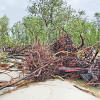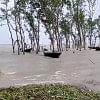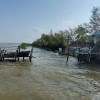Sundarbans: Bangladesh's shield against cyclones

The coastline of Bangladesh has been hammered by cyclones over and over since time immemorial. Situated at the tip of the Bay of Bengal, this region is one of the most susceptible places in the entire world when it comes to cyclones and storm surges.
But if nature puts us in the way of harm, nature also has its own ways of protecting us. The Sundarbans, a green shield on Bangladesh's south-western coast, has protected us from numerous deadly cyclones. Remal, the latest in the line of devastating cyclones coming from the Bay of Bengal, is set to make landfall this evening on the same south-western coast, along the Bangladesh-India border.
So, how does the Sundarbans make this stand against cyclones time and again? How significant is its role in protecting the densely populated localities inland?
In recent memory, one of the most powerful cyclones to hit the Bangladesh coast was Cyclone Sidr, in 2007. Delivering winds at the devastating speed of up to 250 kilometres per hour, the initial thrust of the cyclone was sustained by the Sundarbans. According to research published by a team of researchers from Bangladesh University of Engineering Technology (BUET) in 2015, the mangrove forest sacrificed around 30 percent of its plant population during the cyclone.
The dense forest cover and vegetation provided by mangrove forests on the edge of a landmass defend against cyclones in two major ways: restricting surge height, and reducing water velocity. In 2019, a research paper, published in PLoS One by researchers from the World Bank and Institute of Water Modelling, Dhaka, specifies that the cyclone's effects are mitigated by mangrove forests through the tree roots, trunks, and leaves obstructing the flow of water.
Both research papers used data available from Cyclone Sidr to model how the impact of tropical cyclones are reduced by mangrove forests.
In the BUET paper, titled "Sundarban as a Buffer against Storm Surge Flooding", the researchers concluded that the mangrove forest reduces cyclone damage by reducing the inundated area following a cyclone and storm surge, as well as by keeping the water height lower than it would have been. They also observed that the effects of the mangrove forest are more significant depending on how directly the cyclone impacts the forest. For example, in 2007, Sidr passed close to the edge of the Sundarbans, and still reduced inland damages significantly. However, had it gone through the centre of the Sundarbans, the reduction of cyclone effects would have been even more significant.
The World Bank paper, titled "Quantifying the protective capacity of mangroves from storm surges in coastal Bangladesh", provides some numbers that help to understand just how effective a shield the Sundarbans is when it comes to tropical cyclones. Their calculations yield that mangrove forest cover can reduce surge height by between four and 16.5 centimetres, depending on location, and the types and densities of the trees providing the cover. The median reduction of surge height given by the researchers' observation was 5.5 centimetres.
When it comes to reducing water velocity, the mangrove forest cover managed to reduce it by between 29 and 92 percent, once again depending on location, and the types and densities of trees. The median in the case of water velocity reduction was 59 percent. Interestingly, in the case of both surge height and water velocity reduction, the tree that was most successful was the Keora (Sonneratia apetala).
Cyclones have been a permanent fact of life for people living in the coastal regions of Bangladesh. While the number of cyclones go up or down from decade to decade, and the intensity rises with time, the role of the Sundarbans in protecting inland localities and infrastructure from this damage remains vital.
However, the Sundarbans' ability to ward off these natural disasters and recover in time to face nature's next offering will only sustain if humans can ensure its survival. We have no option but to protect this World Heritage Site from encroachment and deforestation if we are to face the ever increasing challenges of coastal cyclones that are getting more fierce with a rapidly changing climate.

 For all latest news, follow The Daily Star's Google News channel.
For all latest news, follow The Daily Star's Google News channel. 








Comments